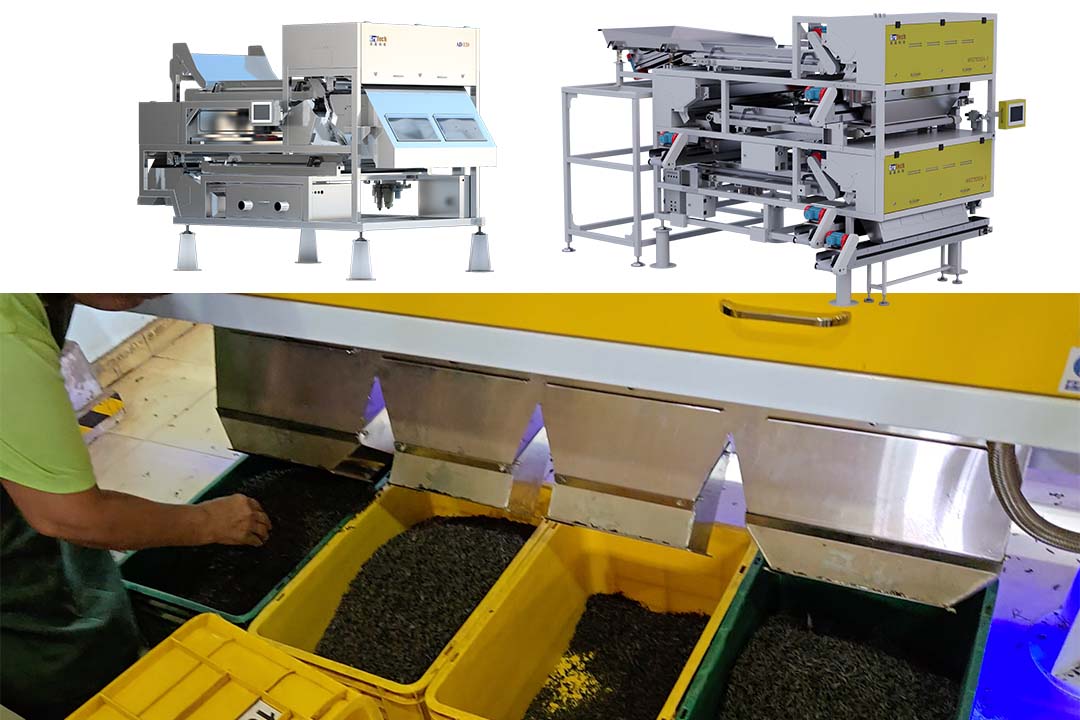In the traditional production of black tea, the sorting process plays a pivotal role in determining product quality and economic efficiency. With the integration of artificial intelligence (AI), the AD120 Primary Sorter and AT120 Precision Grader have emerged as a groundbreaking duo, redefining the workflow of black tea sorting. This article details how these two machines collaborate to transform raw tea leaves into premium-grade products through a seamless, automated process.
Stage 1: Preprocessing and Primary Sorting (AD120)
Objective: Remove stems, deteriorated leaves, and foreign materials to prepare for precision grading.
1. Preprocessing Phase
- Mechanical Kneading: Dried black tea leaves undergo mechanical kneading to break apart clumps, ensuring uniform dispersion for subsequent sorting.
- Preliminary Screening: Fine particles (<1mm) and non-tea impurities (e.g., sand, fibers) are simultaneously removed using vibration sieves.
2. AD120 Primary Sorting
- AI-Driven Recognition: Equipped with high-resolution cameras and Convolutional Neural Networks (CNN), the AD120 captures real-time images of tea leaves.
- Shallow Layers: Detect color variations (e.g., identifying brown, deteriorated leaves).
- Deep Layers: Analyze texture features (e.g., distinguishing stems from leaf connectors).
- Dynamic Ejection: High-speed pneumatic nozzles precisely eject stems (accounting for 10%-15% of raw material) and discolored leaves while preserving intact tea leaves.
- Return Material Characteristics: Post-sorting, the residual material contains≥60% stem-leaf connectors, which can be reprocessed or customized based on client requirements.
Stage 2: Precision Grading (AT120)
Objective: Classify tea leaves by size, shape, and quality to meet diverse market demands.

1. Input Material
- The pre-sorted tea from the AD120 is fed into the AT120 system.
2. AT120 Precision Grading
- Multi-Dimensional Analysis: Leveraging deep learning algorithms and advanced sensors, the AT120 evaluates:
- Size: Using optical sensors to measure leaf dimensions.
- Shape: Identifying round, semi-circular, or oval forms (classified as PEKO grade).
- Texture: Detecting subtle defects (e.g., cracks, uneven edges).
- Reinforcement Learning Optimization: The system continuously refines its sorting strategy based on real-time feedback, adapting to variations in leaf morphology (e.g., half-stem, half-leaf mixes).
- Output Grades:
- OP: Medium leaves (1-3mm).
- OPA: Wider leaves (≥3mm).
- OP1: Slender leaves (~1mm).
- PEKO: Round, semi-circular, or oval leaves.
3. Control and Stability
- Fuzzy PID Algorithm: Adjusts conveyor belt speed dynamically (fluctuation <±0.05m/s) to ensure uniform passage through the detection zone.
- Motion Compensation: Eliminates vibration errors during high-speed operation, achieving a positioning accuracy of±0.1mm.
Synergistic Advantages of the AD120-AT120 System
1. Enhanced Quality
- Minimizes leaf breakage and color degradation (reducing "black-to-dark-gray" shifts), preserving the tea’s original aroma and appearance.
- Removes 99% of residual stems and impurities, significantly boosting product purity.
2. Operational Flexibility
- Customizable deep learning models cater to diverse tea varieties (e.g., Keemun, Dianhong) and client-specific grading criteria.
- Handles complex materials (e.g., mixed stems and leaves) with adaptive sorting strategies.
3. Economic Efficiency
- Reduces labor costs by 30% through full automation.
- Cuts raw material waste by 20% via efficient impurity removal, directly enhancing market value.
The Future of Black Tea Production
The AD120 and AT120 color sorters exemplify how AI-driven technologies are revolutionizing traditional industries. By combining precision, adaptability, and efficiency, this dual-system workflow not only elevates black tea quality but also bridges the gap between heritage and innovation.